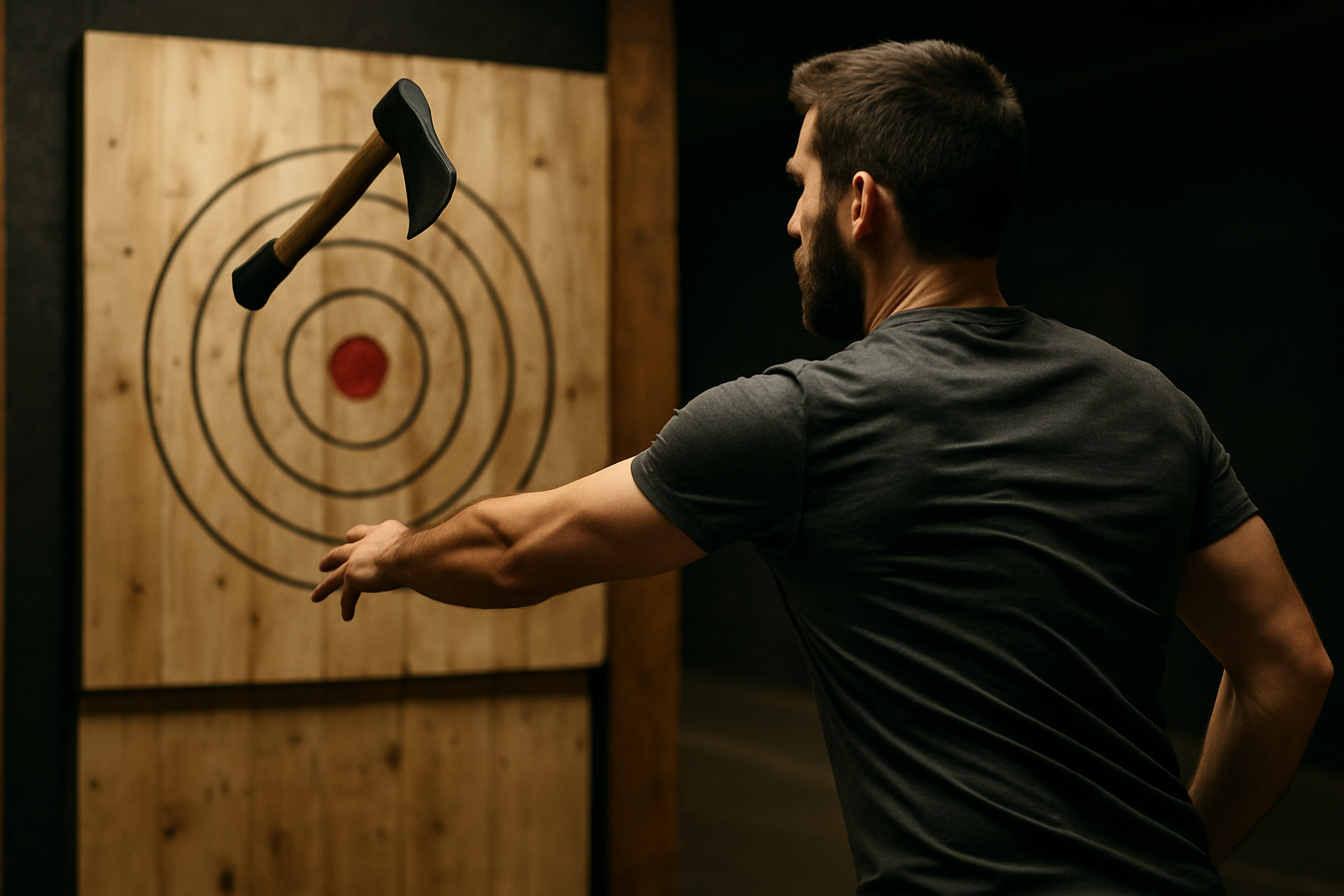Axe Throwing: From Ancient Warfare to Modern Sport
Imagine hurling a razor-sharp axe through the air, watching it spin end over end before striking a wooden target with a satisfying thud. This isn't a scene from a medieval battlefield, but rather a glimpse into one of the fastest-growing recreational sports in North America. Axe throwing has emerged from its humble origins as a tool of survival and warfare to become a thrilling competitive pursuit that's capturing the imagination of urban thrill-seekers and outdoor enthusiasts alike.

Throughout medieval Europe, the francisca, a type of throwing axe, was a popular weapon among Frankish warriors. Its unique design allowed for an unpredictable flight path, making it an effective tool for breaking enemy shield walls. As firearms became more prevalent in warfare, the throwing axe gradually lost its military significance but remained an important tool for hunters and woodsmen.
In North America, Native American tribes such as the Algonquins and Iroquois developed their own throwing axe designs, often incorporating them into hunting and ceremonial practices. European settlers later adopted and adapted these techniques, leading to the development of the iconic American tomahawk.
From Lumberjack Pastime to Urban Phenomenon
The modern sport of axe throwing has its roots in the lumberjack competitions of Canada and the northern United States. These events, which began in the 19th century, showcased the skills of professional loggers and included various axe-related challenges. However, it wasn’t until the early 2000s that axe throwing began to evolve into a standalone recreational activity.
The first commercial axe-throwing venue is believed to have opened in Toronto, Canada, in 2011. This innovative concept quickly gained popularity, spreading to other Canadian cities and eventually making its way into the United States. Today, there are hundreds of axe-throwing venues across North America, Europe, and Australia, catering to a diverse audience ranging from corporate team-building groups to bachelor parties and casual enthusiasts.
The Mechanics of Modern Axe Throwing
At its core, axe throwing is deceptively simple: participants throw an axe at a wooden target, aiming to hit the bullseye. However, mastering the technique requires a combination of strength, precision, and finesse. The standard throwing distance is 12 to 15 feet, and most venues use targets similar to those found in archery ranges.
The axes used in competitive throwing typically weigh between 1.5 and 2.5 pounds and have a handle length of 14 to 19 inches. The throwing motion involves a two-handed overhead throw, with the axe released at the apex of the thrower’s backswing. Proper rotation is crucial; the axe should complete one full rotation before striking the target.
Scoring in axe throwing is straightforward, with points awarded based on where the axe lands on the target. The bullseye is worth five points, with concentric rings decreasing in value. Some venues incorporate additional challenges, such as hitting specific areas of the target or throwing multiple axes in quick succession.
The Rise of Competitive Axe Throwing
As axe throwing’s popularity has grown, so too has its competitive scene. The World Axe Throwing League (WATL), founded in 2017, has emerged as the sport’s primary governing body. WATL oversees international competitions and has established standardized rules and regulations for the sport.
The annual World Axe Throwing Championship, first held in 2018, has quickly become the premier event in the sport. Competitors from around the globe gather to showcase their skills, with events broadcast on major sports networks. The championship features both individual and team competitions, as well as specialty events like dual-axe throwing and long-distance challenges.
In addition to WATL, other organizations such as the International Axe Throwing Federation (IATF) and the National Axe Throwing Federation (NATF) have contributed to the sport’s growth and development. These organizations work to promote axe throwing, organize competitions, and ensure safety standards are maintained across the industry.
The Science Behind the Throw
While axe throwing may seem like a purely physical activity, there’s a surprising amount of science involved in mastering the perfect throw. Understanding the physics of axe rotation, the impact of axe weight and handle length, and the role of biomechanics can give throwers a competitive edge.
One key factor in successful axe throwing is achieving the correct rotation rate. This depends on several variables, including the thrower’s release point, the axe’s weight distribution, and the distance to the target. Skilled throwers learn to adjust their technique based on these factors, often making minute changes to their grip or release point to achieve optimal rotation.
Aerodynamics also play a role in axe throwing, particularly in outdoor competitions where wind can affect the axe’s flight path. The shape of the axe head and the angle of the blade can influence how the axe moves through the air, with some designs offering more stability or predictability than others.
From a biomechanical perspective, axe throwing engages multiple muscle groups, including the core, shoulders, arms, and legs. Proper form involves a full-body motion, with power generated from the legs and core transferred through the arms to the axe. This makes axe throwing an excellent full-body workout, combining elements of strength training and cardio.
Safety and Regulation in Axe Throwing
As axe throwing has transitioned from a niche activity to a mainstream sport, safety concerns have naturally arisen. However, the industry has been proactive in addressing these issues, implementing strict safety protocols and guidelines.
Most axe-throwing venues require participants to undergo a safety briefing and instruction session before throwing. This includes proper throwing technique, target approach, and axe retrieval. Many venues also employ trained “axe masters” who supervise throwing sessions and provide ongoing guidance.
Physical safety measures are also common in axe-throwing facilities. Throwing lanes are typically enclosed on three sides to prevent axes from ricocheting into adjacent areas. Floor markings indicate safe standing areas for throwers and spectators, and many venues use reinforced backstops to prevent axes from penetrating beyond the target area.
The World Axe Throwing League and other governing bodies have established comprehensive safety regulations for competitive events. These include specifications for axe design, target construction, and throwing lane setup. Regular safety inspections and equipment checks are mandatory for sanctioned events.
Despite these precautions, injuries can still occur in axe throwing, as with any physical activity. Most injuries are minor, such as blisters or muscle strains, but more serious incidents have been reported. As the sport continues to grow, ongoing research and development in safety equipment and protocols will be crucial to maintaining its reputation as a safe and enjoyable activity.
The Cultural Impact of Axe Throwing
Beyond its appeal as a recreational activity and competitive sport, axe throwing has had a notable impact on popular culture. The sport’s unique blend of primal skill and modern entertainment has captured the imagination of many, leading to its inclusion in television shows, movies, and even video games.
Axe throwing has become a popular team-building activity for corporations, offering a novel way to promote communication, trust, and friendly competition among colleagues. Many venues offer specialized corporate packages, combining axe throwing with other activities or catering options.
The sport has also found a place in the broader “experience economy,” where consumers increasingly value unique, shareable experiences over material possessions. Axe throwing offers a memorable, Instagram-worthy activity that appeals to millennials and Gen Z consumers seeking novel ways to spend their leisure time and money.
Interestingly, axe throwing has also tapped into a growing interest in traditional skills and “old-world” craftsmanship. Many enthusiasts view the sport as a way to connect with historical practices and develop a skill that was once essential for survival. This has led to crossover interest in related activities such as blacksmithing, woodworking, and primitive survival skills.
The Global Spread of Axe Throwing
While North America remains the epicenter of the axe-throwing phenomenon, the sport has begun to gain traction in other parts of the world. Europe, in particular, has seen a surge in axe-throwing venues, with facilities opening in major cities across the continent.
In the United Kingdom, axe throwing has found a natural home alongside other “pub games” like darts and skittles. Many British axe-throwing venues combine the sport with traditional pub atmospheres, offering food and drinks alongside throwing lanes.
Australia and New Zealand have also embraced axe throwing, with the sport’s rugged image resonating with the outdoor-loving culture of these countries. Venues in these regions often incorporate local themes and challenges, such as throwing at targets shaped like indigenous animals.
In Asia, axe throwing is still in its infancy but is beginning to gain attention. Countries like Japan and South Korea, known for their enthusiasm for novel entertainment concepts, have seen the opening of axe-throwing facilities in major urban centers.
As the sport continues to spread globally, it’s likely to evolve and adapt to local cultures and preferences. This could lead to the development of new throwing styles, target designs, and competitive formats, further enriching the world of axe throwing.
The Future of Axe Throwing
As axe throwing continues to grow in popularity, the sport faces both opportunities and challenges. One key area of development is technology integration. Some venues are experimenting with digital scoring systems and augmented reality targets, which could enhance the competitive experience and provide more detailed performance analytics for serious throwers.
Environmental concerns are also shaping the future of axe throwing. With sustainability becoming increasingly important to consumers, many venues are exploring eco-friendly target materials and implementing recycling programs for worn-out axes and targets. Some facilities are even experimenting with “virtual” axe throwing using projection technology, eliminating the need for physical targets altogether.
The competitive side of axe throwing is likely to see continued growth and professionalization. As prize money and sponsorship opportunities increase, we may see the emergence of full-time professional axe throwers. This could lead to more advanced training techniques, specialized equipment development, and a higher level of athleticism in the sport.
Education and outreach will be crucial for the long-term success of axe throwing. Many venues are developing youth programs and school partnerships to introduce the sport to younger generations. These initiatives often focus not just on the physical aspects of axe throwing but also on its historical significance and the mental focus it requires.
As the sport matures, there’s potential for axe throwing to be considered for inclusion in multi-sport events or even the Olympic Games. While this may seem far-fetched, other niche sports like skateboarding and sport climbing have successfully made the transition to Olympic status in recent years.
The Therapeutic Potential of Axe Throwing
An unexpected benefit of axe throwing’s rise in popularity has been the discovery of its potential therapeutic applications. Mental health professionals and recreational therapists have begun to explore the use of axe throwing as a tool for stress relief, anger management, and building self-confidence.
The physical act of throwing an axe can serve as a cathartic release for pent-up emotions, while the focus required to hit the target can help individuals practice mindfulness and present-moment awareness. The immediate feedback provided by successfully sticking an axe in the target can boost self-esteem and provide a sense of accomplishment.
Some addiction recovery programs have incorporated axe throwing into their treatment plans, finding that it provides a healthy outlet for energy and emotions while fostering a sense of community among participants. Veterans’ organizations have also embraced the sport, using it as a way to help service members transition to civilian life and cope with PTSD.
Research into the therapeutic benefits of axe throwing is still in its early stages, but anecdotal evidence suggests that it may have a role to play in holistic approaches to mental health and well-being. As the sport continues to grow, it’s likely that we’ll see more formal studies examining its potential psychological and emotional benefits.
Axe Throwing and Gender Equality
One of the most positive aspects of axe throwing’s evolution as a sport has been its inclusivity, particularly in terms of gender representation. Unlike many traditional sports where physical strength can create significant advantages, axe throwing relies more on technique and precision than raw power.
This has resulted in a competitive landscape where men and women often compete on equal footing. In fact, several of the sport’s top-ranked competitors and world champions are women. This gender parity has helped make axe throwing an attractive option for individuals seeking a sport that offers true equality of opportunity.
Many axe-throwing venues and leagues have made conscious efforts to create welcoming environments for women, hosting ladies’ nights and all-female competitions. These initiatives have helped to break down stereotypes about “masculine” activities and encouraged more women to try their hand at the sport.
The inclusive nature of axe throwing extends beyond gender, with the sport attracting participants from diverse age groups, backgrounds, and physical abilities. Adaptive axe throwing, which modifies equipment and techniques for individuals with disabilities, is an emerging area that further demonstrates the sport’s commitment to accessibility.
The Environmental Aspect of Axe Throwing
As environmental consciousness grows globally, the axe-throwing industry is increasingly focusing on sustainability. The sport’s reliance on wooden targets and handles presents both challenges and opportunities in terms of environmental impact.
Many axe-throwing venues are partnering with local sawmills and woodworkers to source sustainably harvested wood for their targets. Some facilities have implemented target rotation systems to extend the life of each board, while others are experimenting with composite materials that offer increased durability without sacrificing the authentic feel of wood.
The production of axes themselves is also evolving with environmental concerns in mind. Some manufacturers are exploring the use of recycled metals for axe heads and sustainable wood or composite materials for handles. There’s also growing interest in the concept of “heirloom quality” axes that are built to last for generations, reducing the need for frequent replacements.
Beyond equipment considerations, the axe-throwing community is increasingly involved in environmental initiatives. Many venues organize tree-planting events or partner with conservation organizations, recognizing the connection between their sport and the natural world. Some competitions now include an environmental component, with prizes awarded for eco-friendly innovations in axe design or target construction.
As the sport continues to grow, balancing its expanding popularity with environmental responsibility will be crucial. The axe-throwing community’s proactive approach to these issues suggests a promising future where thrilling competition and environmental stewardship can coexist.
Conclusion: The Enduring Appeal of Axe Throwing
From its ancient origins as a tool of warfare to its current status as a thriving recreational sport, axe throwing has undergone a remarkable transformation. Its appeal lies in its unique combination of primal satisfaction and modern entertainment, offering participants a chance to connect with history while enjoying a thoroughly contemporary social experience.
As axe throwing continues to evolve, it faces both challenges and opportunities. Maintaining safety standards, promoting inclusivity, and addressing environmental concerns will be crucial for the sport’s long-term success. At the same time, technological innovations, therapeutic applications, and global expansion offer exciting possibilities for growth and development.
Whether as a competitive pursuit, a social activity, or a form of stress relief, axe throwing has carved out a unique niche in the world of sports and recreation. Its ability to adapt and resonate with diverse audiences suggests that this ancient practice will continue to thrive in the modern world, connecting people with their primal instincts and with each other in surprising and meaningful ways.
As we look to the future, it’s clear that axe throwing is more than just a passing trend. It’s a testament to the enduring human desire for challenge, skill development, and connection to our ancestral roots. In a world increasingly dominated by digital experiences, the simple act of throwing an axe at a wooden target offers a refreshing return to tangible, physical engagement with the world around us.
The journey of axe throwing from battlefield to bar game is a fascinating example of how human activities can evolve and find new relevance across centuries. As the sport continues to grow and develop, it will undoubtedly write new chapters in its already rich history, inspiring and engaging generations to come with the timeless thrill of a well-thrown axe.





